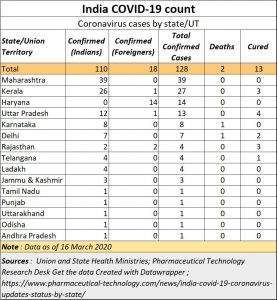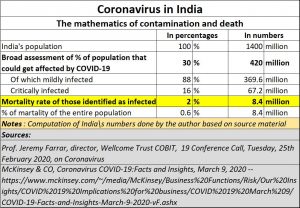An edited version of this article appeared at https://www.cnbctv18.com/healthcare/coronavirus-what-india-can-learn-from-singapore-in-fighting-the-disease-5508351.htm
Coronavirus: lessons from Singapore
RN Bhaskar — 18 March 2020
India is in various stages of a lockdown. In many cities and even states, schools and colleges have been closed. People have been advised to work from home in most major cities. In Mumbai, the government has threatened to stop the trains in case people don’t stop using them. How ironic!
Like always, banning, restricting, and closing are measures that come easily to India’s administrators. It thinks bans can be the best solution – whether it is a book, or an agitation, or even viruses.
Maybe it should look to Singapore. Maybe, the talk that Singapore’s prime minister Lee Hsien Long gave to his nation on 12 March 2020 (https://www.facebook.com/125845680811480/posts/3111854648877220/) is one that policymakers should pay heed to very seriously.
Singapore has managed to achieve a zero-death rate, till now. It has refused to shut down schools, colleges or offices. People don’t wear masks ad move around nervously. Life goes on as normal.
That is because Singapore knows business and commerce are equally important for the health of a nation as protection from viruses. So, it does all it can to prevent the virus from spreading. But it also tries to ensure that normal work goes on. And in order to protect the daily wage earner or the self-employed worker, who may have to be compulsorily quarantined, Singapore pays him $100 a day during this incarceration.
The only ban that has been imposed is that on public gatherings, conferences, religious meetings and the like.
So how does Singapore prevent the spread of this epidemic? It does the following:
- Do not stop normal business.
- Keep schools and colleges open, but constantly monitor and check the state of health of all the students every day both at the time of entry and exit. If there are signs of infection, immediately trace their contact circle – home, friends. Begin testing their health as well. After studying China (which China did not have the benefit of), Singapore realized that children and the young are usually safe. But they can be carriers of the infection. So, monitor them. They will point to the people who actually need to be monitored.
- If the monitored people test positive, begin the process of isolation and treatment. The mild attacks go away soon. The serious may require intensive care – including respirators. Use them immediately before the lungs actually collapse. By doing this, Singapore has ensured that to date, it does not have a single death on account of this virus. And by offering the daily wage earner and the self-employed a daily support of $100, the government ensures that they respect isolation and quarantine.
- Ensure hygiene and constant monitoring at all public places – trains, bus-stops, and local markets. Constant monitoring is the price you pay for ensuring a healthy environment and a thriving business even in the midst of collapse the world over. Testing and basic treatment are free for coronavirus, irrespective of whether the patient is Singaporean or a foreigner. The government there knows that the cost of not treating such a patient would be much more than of providing treatment.
- Be prepared to take up business opportunities as and when they arrive, as the world begins to experience gaps and time lags in recovering.
So, what can India do?
First ensure that more and more tests are conducted, to identify the people who need to be treated.
Second, do not shut down schools and colleges, but prevent crowding. And do not slip up on either hygiene at all times, and constant monitoring.
 Third, get the insurance companies to take charge of both testing through private clinics and treatment through hospitals. By linking these through insurance, they promote insurance on the one hand, and use their clout of numbers and finance to bring clinics and hospitals to toe the line, backed by suitable legislation. Using lessons from what Senegal has done, it could galvanise production of less expensive testing kits in India. It may be recalled that the 10-minute-$1-coronavirus-test-solution – developed by the U.K.-based Mologic Ltd., in collaboration with Senegalese research foundation Institut Pasteur de Dakar — could be a gamechanger for the world in less than three months’ time (https://www.bloomberg.com/amp/news/articles/2020-03-16/ten-minute-coronavirus-test-could-be-game-changer-for-africa).
Third, get the insurance companies to take charge of both testing through private clinics and treatment through hospitals. By linking these through insurance, they promote insurance on the one hand, and use their clout of numbers and finance to bring clinics and hospitals to toe the line, backed by suitable legislation. Using lessons from what Senegal has done, it could galvanise production of less expensive testing kits in India. It may be recalled that the 10-minute-$1-coronavirus-test-solution – developed by the U.K.-based Mologic Ltd., in collaboration with Senegalese research foundation Institut Pasteur de Dakar — could be a gamechanger for the world in less than three months’ time (https://www.bloomberg.com/amp/news/articles/2020-03-16/ten-minute-coronavirus-test-could-be-game-changer-for-africa).
Fourth, wherever additional comfortable transport can be provided, encourage offices to remain open. Prevent crowding, but do not prevent commerce. How the government does this given Indian conditions is something that policymakers will have to work out depending on conditions that vary from place to place.
Fifth, move away from not testing the asymptomatic (https://indianexpress.com/article/india/coronavirus-icmr-senior-scientist-nivedita-gupta-have-1-5-lakh-test-kits-and-have-ordered-1-million-more-6317841/). The more the testing, the greater the containment.,
 The result of the low number of tests is the low numbers of infection and deaths. In fact, reality will hit India hard when bodies start piling up in mortuaries and crematoriums. The mathematical models developed by medical authorities point to this possibility (see chart)
The result of the low number of tests is the low numbers of infection and deaths. In fact, reality will hit India hard when bodies start piling up in mortuaries and crematoriums. The mathematical models developed by medical authorities point to this possibility (see chart)
See the other chart on people infected. India tests barely 6,000 people a day, while countries with smaller populations test more people. The US tests 8,000 people daily, Japan tests 9,600, France 12,000, the UK 13,000), and Italy 23,000. South Korea has conducted as many as 2 lakh in al, which is why, say experts, Korea has seen declining numbers (https://indianexpress.com/article/explained/india-coronavirus-tests-icmr-6317845/). As stated by Dr. T Sundararaman, former director of the National Health Systems Resource Centre, in a media interview (https://timesofindia.indiatimes.com/india/low-testing-could-explain-indias-small-covid-numbers/articleshow/74661955.cms), “Bihar has only one testing centre . . . . . Having just 52 centres across India makes no sense. And not even all of these are fully functional.”










































COMMENTS